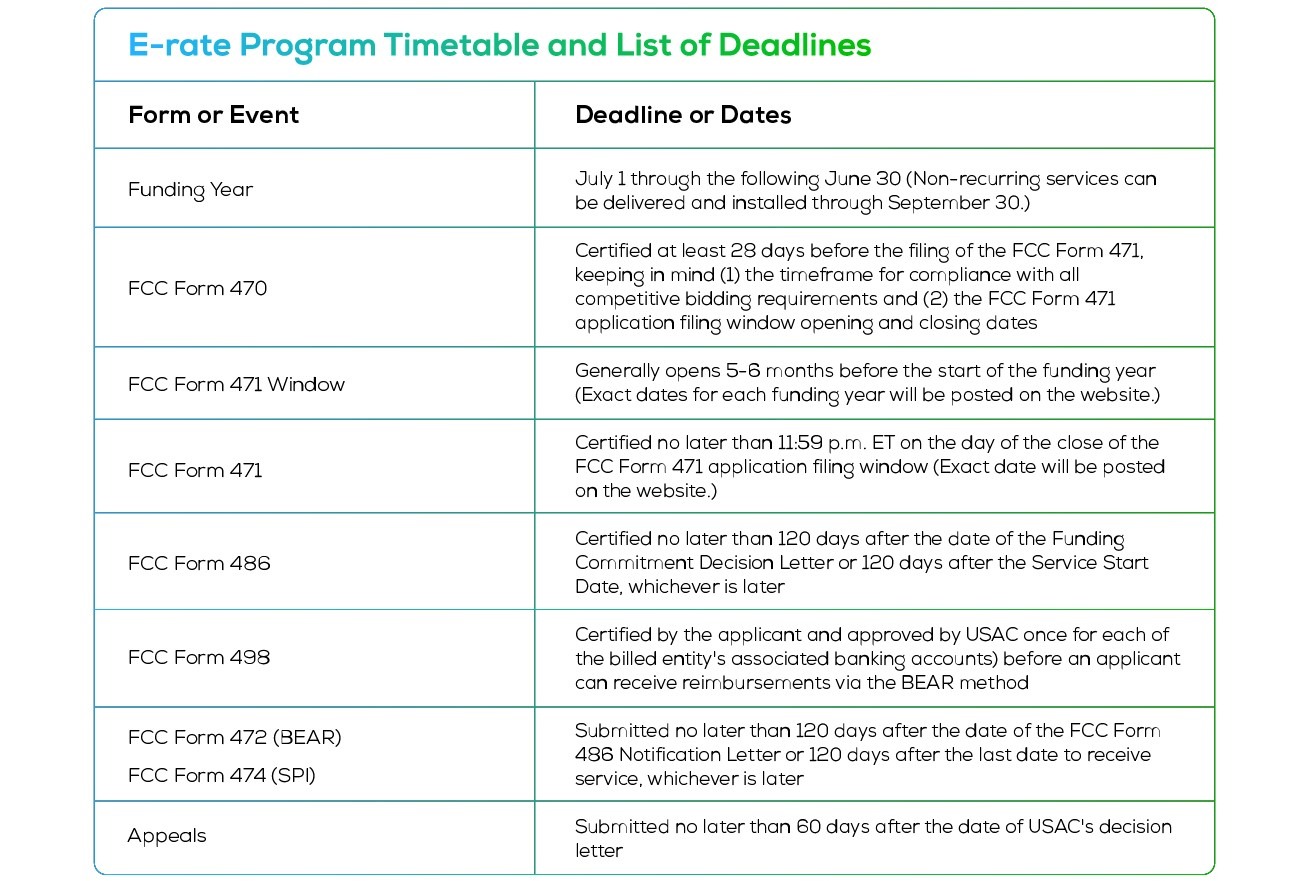As COVID relief funding sunsets this September (funds must be committed by 9/30), the Federal Communications Commission’s (FCC) annual E-Rate Program will become increasingly important for schools and libraries seeking to refresh and maintain their technology stack. To help education leaders understand the timeline, eligibility requirements, and relevant updates to the program—for which 2025 is the last year for the current five-year Category 2 funding cycle (FY2021-2025)—UDT has pulled together a resource covering all things E-Rate.
*Please refer to the Universal Service Administrative Company for additional information, including their “How to File an FCC Form 470” learning module and “FCC Form 470 Services Guiding Statements Reference Table FY2025” to help get started with the FY2025 competitive bidding process.
Aug. 2, 2024 (USAC Announcement) – The learning module walks applicants through the steps for submitting Category 1 and Category 2 bid requests for School Bus Wi-Fi and Wi-Fi Hotspots for Off-Premises Use equipment and services. The guiding statements document provides a table to help determine which dropdown menus to select on the FCC Form 470 when requesting specific types of equipment and services.
Empowering Schools & Libraries With E-Rate
When the FCC established its E-Rate Program in 1996, only 14% of the United States’ K12 classrooms had access to the Internet. Today tells a different story, with 67% of school districts across the country now meeting the bandwidth target of 1 Mbps per student. Of course, that still leaves 23.5 million students without improved Internet access.
It’s clear that while the E-Rate Program stands as a transformative force for education, it’s clear that while E-Rate is a transformative force for education, there is still some confusion around the filing and funding process. Some eligible school districts and library systems don’t realize they can leverage E-Rate for more than just connectivity hardware.
E-Rate funding can also open the doors for Managed Internal Broadband Services (MIBS)—an investment in covered services like network monitoring and management, as well as repair or replacement for eligible hardware (think cabling, wired data networking equipment, firewalls, caching devices, and more). The best part? MIBS can be purchased with or without equipment on an organization’s E-Rate application.
E-Rate is designed to help schools and libraries gain access to reliable, high-speed connectivity. When utilized appropriately, it can empower institutions to create seamless digital experiences for students and patrons alike (but more on this later).
To help E-Rate-eligible institutions get the most out of this program, we’re delving into the true scope of E-Rate’s far-reaching and profound impact. Our goal is to assist in realizing the program’s mission and purpose of bolstering educational experiences and empowering institutions to offer enhanced connectivity, opening doors to vital resources, and cultivating innovative learning environments.
We’ll also be answering key questions, including:
What is the E-Rate Program and how does it support schools and libraries?
Who qualifies to participate in the E-Rate Program and benefit from its resources?
How can participating in the E-Rate Program benefit eligible organizations?
What funding percentages are associated with each E-Rate category?
What types of services and technologies does the E-Rate Program cover?
How can educational institutions make the most of their E-Rate benefits?
What are the key dates and deadlines for the E-Rate Program application timeline?
What is happening with the Schools and Libraries Cybersecurity Pilot Program?
What are the characteristics of a good E-Rate service partner?
Understanding the E-Rate Program: What is the E-Rate Program and how does it support schools and libraries?
The E-Rate Program is a transformative government initiative. It’s designed to bridge the digital divide and empower educational institutions, including schools and libraries, with the essential technology resources that ensure connectivity. However, it’s more than just a funding mechanism; it’s also a catalyst for providing equitable access to the digital world.
At its heart, the E-Rate Program, officially known as the Universal Service Program for Schools and Libraries, acknowledges the critical role that technology and Internet connectivity play in enhancing education. It recognizes that in the digital age, learning experiences extend beyond traditional classroom boundaries.
The E-Rate Program functions by providing eligible educational institutions with up to 90% discounts on telecommunications services, Internet access, and internal connections. These discounts alleviate the financial burden on institutions, allowing them to channel resources into other crucial aspects of education. By facilitating access to high-speed broadband, Wi-Fi networks, and digital tools, the program helps create an environment where students can explore, learn, and develop essential skills for the future.
At its core, the E-Rate Program aims to level the playing field, ensuring that institutions regardless of their geographic location or economic status can offer students and patrons the same opportunities to explore the digital world.
A central figure in the E-Rate Program’s administration is the FCC. It oversees the program, ensuring that its goals and objectives are met efficiently and effectively. The commission plays a crucial role in setting guidelines, defining eligible services, and establishing the rules that govern the program. Through its leadership, the FCC ensures that the E-Rate Program remains a reliable avenue for educational institutions to access the technology resources they need to explore, learn, and succeed.
Eligibility Criteria: Who qualifies to participate in the E-Rate Program and benefit from its resources?
The E-Rate Program extends its resources to a diverse range of eligible entities. To understand who qualifies, let’s delve into the definitions, specific criteria, and the significance of meeting eligibility requirements.
- K12 Schools: K12 schools encompass elementary, middle, and high schools, providing education to students from kindergarten through twelfth grade. These schools play a fundamental role in shaping the academic journey of students. To qualify for the E-Rate Program, K12 schools must be recognized as eligible by their respective state education departments.
- Public Libraries: Public libraries are community hubs of information and learning, offering a wide range of resources to patrons. Eligible public libraries include those that are listed in the Institute of Museum and Library Services’ (IMLS) database and serve the public without charge for access to their materials and services.
The program’s reach and impact depend on rigorous adherence to these criteria, ensuring that its resources are directed to the institutions and communities that truly require them.
For example, discount rates are assigned based on economic need, with schools and libraries in higher-poverty areas receiving higher discounts. It’s also worth noting that urban and rural classifications are utilized to determine these discount levels, recognizing the unique challenges faced by different locations.
Advantages for Institutions: How can participating in the E-Rate Program benefit eligible organizations?
The E-Rate Program acts as a catalyst for transforming the educational landscape by facilitating improved access to online resources and advanced communication tools. It’s a powerful mechanism that addresses the digital divide, ensuring that students and patrons have equitable access to technology and digital information, regardless of their socioeconomic background.
Beyond financial aid, the program focuses on creating an environment where technology plays a pivotal role in fostering academic growth, innovation, and community engagement through connectivity. One prime example of the broader benefits offered by the E-Rate Program is MIBS.
Unlike Basic Maintenance of Internal Connections (BMIC), which covers the repair and upkeep of eligible internal connections with specific requirements for support, MIBS encompasses the services provided by a third party for the operation, management, and monitoring of eligible broadband internal connections components, like access points, routers, switches, hubs, and wiring (this includes Managed Wi-Fi, for example). MIBS empowers schools and libraries to establish, maintain, manage, and monitor reliable networks that facilitate efficient communication, collaborative learning, and resource-sharing, directly driving educational outcomes.
From virtual classrooms and online research to interactive educational content, MIBS enables schools and libraries to harness the full potential of their connections. It ensures that students can access online resources without disruption, educators can engage with immersive teaching methods, and libraries can offer a wealth of digital content. In a world where connectivity is integral to learning, MIBS is the backbone that supports these critical endeavors.
As part of the E-Rate Program’s broader benefits, MIBS plays a fundamental role in elevating the quality of education and access to information. By addressing infrastructure gaps and providing reliable connectivity, the program contributes to the creation of well-rounded, tech-savvy students and informed communities. Moreover, the increased access to online resources fosters a dynamic learning environment where educators can personalize instruction and students can explore diverse subjects beyond the classroom.
But in order to benefit from MIBS, school districts and library systems must understand how to factor them into their Form 470 appropriately when they apply for E-Rate. Please refer to USAC’s learning module for detailed instructions on how to accurately fill out the Form 470.
Covered Services and Technologies: What types of services and technologies does the E-Rate Program cover?
The services and technologies covered by the E-Rate Program are tailored to address the specific needs of modern learning environments and ensure that students and patrons have equitable access to vital connectivity resources.
They include:
- Internet Access: At the heart of the program is the provision of reliable and high-speed Internet access. This service forms the foundation for various online learning activities, research endeavors, and communication tools that are integral to today’s education system.
- Wi-Fi Connectivity: The program recognizes the significance of seamless wireless connectivity within educational premises. Wi-Fi technology enables students, teachers, and other patrons to access online resources, collaborate on projects, and engage in interactive learning experiences from anywhere.
- Broadband Services: Broadband is the lifeline of modern connectivity. E-Rate supports institutions in obtaining and maintaining broadband services that ensure optimal online experiences. Whether for video conferencing, virtual classrooms, or data-intensive research, broadband services are essential for operations to run smoothly.
Benefit Allocation: What funding percentages are associated with each E-Rate category?
The E-Rate Program’s funding structure is designed to accommodate various needs while promoting equitable access to technology. It covers two classifications of funding:
- Category 1 Services: This category includes telecommunications services, Internet access, and data transmission. Funding for Category 1 services is typically provided at a higher percentage, reflecting their essential nature in establishing the digital infrastructure. Schools and libraries can receive up to 90% of the eligible costs for these services.
- Category 2 Services: Under Category 2 are services and technologies that enhance the internal connectivity of eligible institutions. This encompasses Wi-Fi networks, routers, switches, and other internal components. Funding for Category 2 services is distributed as a set dollar amount per student, with varying levels of support depending on the school’s location and economic need.
It can be beneficial to work with an E-Rate service provider with capabilities across Category 1 and Category 2, as it eliminates the hassle and expense of working with multiple partners to achieve the organization’s connectivity goals.
Program Benefits: What types of services and technologies does the E-Rate Program cover?
As of 2024, the E-Rate Program encompasses five distinct benefits, each catering to different aspects of enhancing digital connectivity and technological infrastructure within educational institutions:
- Data Transmission Services & Internet Access (IA): Data transmission services cover broadband connectivity and basic conduit access to the Internet. This service type covers Wi-Fi on school buses, leased lit fiber, leased dark fiber, and self-provisioned broadband networks. These services cannot include charges for content, end-user devices, or equipment purchases (other than those necessary for transmission of Category 1 services). *As of Funding Year 2019, voice services are no longer eligible.
- Internal Connections: Internal connections refer to eligible equipment, such as routers, switches, wireless access points, and cabling, which are necessary to transport or distribute broadband within one or more instructional buildings of a single school campus or within one or more non-administrative buildings that comprise a single library branch.
- Basic Maintenance of Internal Connections: Maintenance is vital to sustain the longevity and functionality of technology infrastructure. This category includes routine upkeep, repairs, and technical support for eligible equipment (internal connections). Proper maintenance ensures that devices remain operational, minimizing disruptions to the learning environment.
- Managed Internal Broadband Services (MIBS): MIBS are provided by a third party for the operation, management, and monitoring of internal connections components. E-Rate support is limited to eligible expenses or portions of expenses that directly support and are necessary for the broadband connectivity within schools and libraries.
Maximizing E-Rate Benefits: How can educational institutions make the most of their E-Rate benefits?
Having a technology strategy or plan can prove beneficial for eligible institutions seeking to make the most of available funding. Our experts have suggested some essential steps for taking this approach:
- Strategic Planning and Budget Allocation: Allocate E-Rate funding strategically to address the most critical areas. Begin by aligning the institution’s technology needs with educational goals. Create a comprehensive technology plan that outlines the services, solutions, and upgrades required to enhance learning experiences.
- Comprehensive Needs Assessment: Prioritize projects that will have the greatest impact on student learning and overall operations. Conduct a thorough assessment of the institution’s connectivity infrastructure and support requirements, then prioritize accordingly.
- Enhancing Connectivity and Access: Utilize E-Rate funding to improve Internet connectivity across the institution. By providing reliable, high-speed Internet access, the organization enables seamless online learning, research, and communication. Ensure any potential providers have the right capabilities, expertise, and experience to optimize awarded E-Rate funding.
- Supportive Infrastructure and Maintenance: Allocate a portion of funding awarded to maintain and upgrade internal connections and equipment. A well-maintained infrastructure ensures that the technology remains operational and accessible to all users at all times.
- Continuous Evaluation and Improvement: Regularly assess the impact of the technology investments made through E-Rate funding. Gather feedback from educators, students, and other patrons to understand their experiences. Use this feedback to refine the organization’s technology strategy and make informed decisions for future initiatives.
Application Timeline: What are the crucial dates and deadlines for the E-Rate Program application process?
Missing deadlines can impact an institution’s ability to secure E-Rate funding and acquire the necessary services and technologies to stay connected. As such, applicants must meticulously follow the program timeline to ensure applications are reviewed promptly and funding decisions are reached within the desired timeframe:

By understanding and adhering to these crucial dates and deadlines, educational institutions can optimize their chances of successfully navigating the E-Rate application process and accessing the funding that supports their technological needs.
*Please refer to USAC for the most up-to-date deadlines and announcements.
Navigating the Application Process: How do eligible institutions apply to the E-Rate Program?
To apply, potential applicants should visit USAC and review their applicant process. When you are ready to apply, you will be directed to either create or login to an existing E-Rate Productivity Center (EPC) account.
Taking a strategic approach can help an organization successfully prepare to navigate the E-Rate Program and optimize their use of funding. Here are three best practices eligible institutions might consider tapping to streamline their experience:
- Have a Technology Strategy/Plan: Crafting a comprehensive technology plan can help organizations outline their goals, needs, and strategies for integrating technology into the educational environment. This plan can then serve as a roadmap to inform how they might allocate E-Rate funds.
- Submit Requests Completely and Accurately: Once a technology plan is in place, institutions can proceed to submit funding requests. This involves completing the necessary application forms, with two playing a central role:
- Form 470: This form is used to announce the institution’s technology needs and solicit bids from service providers. It helps institutions identify the solutions and services that best align with their requirements.
- Form 471: After evaluating bids and selecting providers, institutions complete a Form 471 to officially request E-Rate funding for the chosen services. This form includes details about the requested services, costs, and provider information.
- Adhere to Deadlines and Guidelines: Timeliness is paramount in the E-Rate application process. Missing deadlines or failing to follow guidelines can result in delays or even rejection of funding requests.
Choosing a Provider: What are the characteristics of a good E-Rate service partner?
The ideal E-Rate service provider possesses several characteristics that contribute to a smooth and successful experience. You want to work with a partner that has the following qualities:
- Expertise: A seasoned provider has a deep understanding of E-Rate rules and regulations. They are also committed to staying up to date on the latest changes and compliance requirements to the program.
- Customization: The provider will tailor solutions to the specific needs of each institution, ensuring that funding requests align with an organization’s technology plan/strategy.
- Support: An exceptional provider offers comprehensive support that adheres to program rules, from helping navigate the paperwork required for E-Rate payment and reimbursement, to preparing and filing appeals, and more.
- Reliability: Reliable providers don’t just ensure you submit the right paperwork on time, they make the post-award E-Rate process easy so eligible schools and libraries can prioritize serving students and patrons.
New to E-Rate: What is happening with the Schools and Libraries Cybersecurity Pilot Program?
Schools and libraries are often targeted by malicious actors that seek to steal personal information, compromise accounts, cause harm or embarrassment, or otherwise disable/disrupt critical networks that provide broadband connectivity. On June 11, 2024, the FCC released a Report and Order establishing the Schools and Libraries Cybersecurity Pilot Program to gather the data needed to better understand whether and how universal service funds could be used to support the cybersecurity needs of schools and libraries.
This three-year Pilot Program, administered by USAC with oversight by the FCC, aims to address cybersecurity threats facing E-Rate eligible institutions by providing up to $200 million in universal service support to eligible schools and libraries to defray the cost of eligible cybersecurity services and equipment. The Pilot Program will follow many of the processes used in the E-Rate program, including competitive bidding, requests for eligible service and equipment, and a reimbursement process.
This fall, the FCC will open an application filing window for entities that are interested in participating in the Pilot Program. Eligible institutions will be able to apply to participate through a two-part process using a newly created FCC Form 484.
- In Part 1, interested applicants will share information about their school, library, or consortia and the type of cybersecurity services and equipment they would request if selected for the Pilot Program. Approved participants will be required to provide more detailed information about their cybersecurity experiences in Part 2 of the application.
- The FCC will select a diverse selection of eligible institutions who complete the FCC Form 484 to participate in the Pilot Program, with a focus on selecting applicants with the greatest need.
To see the latest information on the Pilot Program, including its timeline and trainings, please refer to USAC’s Cybersecurity Pilot web page and sign up for Pilot Program emails. Interested applicants can also visit the FCC’s Cybersecurity web page.

You want the E-Rate process to be easy—and UDT knows E-Rate.
Enjoy the support of a dedicated team of experts for your post-award E-Rate experience and optimize funding around your unique needs with UDT. With over a decade of experience delivering full-coverage technology and IT solutions to K12 districts around the nation, we at UDT pride ourselves on providing professionalism, ethics, reliability, accuracy, and discernment in helping clients optimize E-Rate discounts.
What You Get With UDT
- A Supported E-Rate Experience: We take the post-award grunt work off your plate, so you can focus on other priorities, like delivering top-notch learning experiences for your students. Our primary objective is to help you make the most of the E-Rate process, including optimizing your funding and maintaining 100% compliance with program rules.
- The Latest E-Rate Expertise: UDT knows how to juggle the nuances associated with the E-Rate program. We keep everyone on our team—including our experts, leadership, and even our account billing department—trained on the latest in E-Rate to guarantee compliance with program rules and ensure the process remains seamless for you. We are also a part of advocacy organizations like CoSN and utilize the guidance of experienced third-party consultants who’ve worked with school districts and the E-Rate Program for years.
- Full-Coverage E-Rate Delivery Capabilities: Our state-of-the-art Integration and Support Center is equipped with all that is required to order, stage, asset track, install, and manage all E-Rate-eligible equipment. UDT also provides solutions across Lifecycle Services, Cybersecurity, IT Managed Services, Cloud Infrastructure, and more ensuring full coverage for your unique needs.
- Logistical Support and Collaboration: When we say we will handle all things E-Rate, (within program rules) we mean it. As allowable, UDT can work with you on any paperwork associated with the E-Rate payment and reimbursement process and/or USAC or FCC appeals; track FCC decisions affecting the program and provide guidance; monitor all appeals and audit decisions issued by the FCC; monitor all Schools and Libraries Division (SLD) board meetings and public communications; and communicate regularly with federal and state education officials, FCC and congressional staff, and other members of the technology and education community.
- A Reputation You Can Count On: UDT has supported K12 with world-class technology and IT services since 1995. We currently serve 8 of the 10 largest K12 school districts in the nation and rank among the top Category 2 providers nationwide. We’re also pleased to be expanding services in Category 1.
Schedule your technology strategy consultation and see how you can benefit from UDT’s full-coverage capabilities. It’s as easy as 1-2-3.
Prepare for the pending E-Rate application season—from the logistics and requirements of submission and eligibility to how to optimize spending—with our free “E-Rate Made Easy” webinar series featuring expert speakers from UDT and our partners. Space is limited, so secure your spot today.











